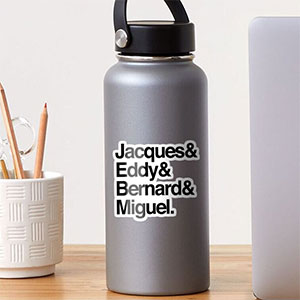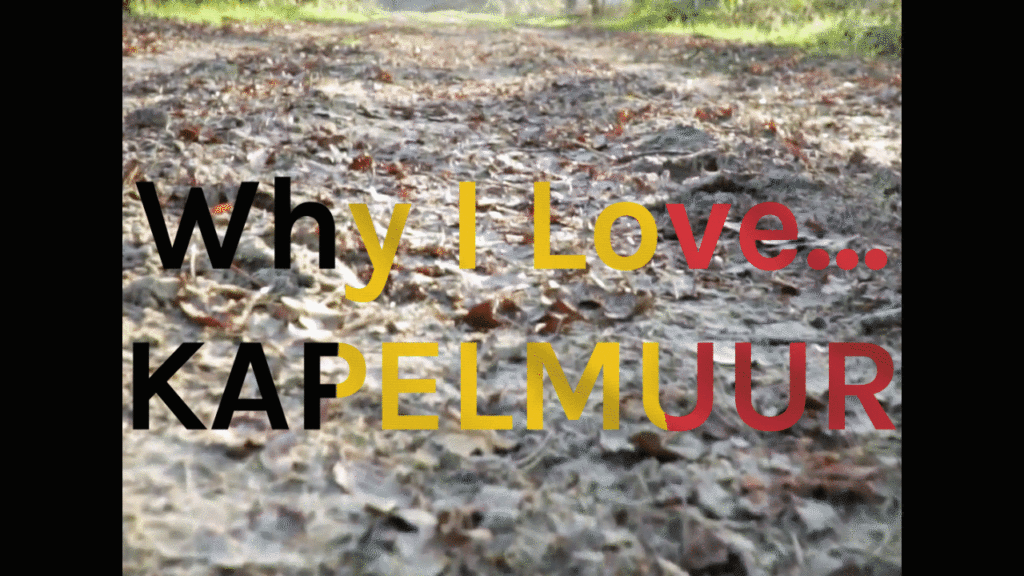
The Muur-Kapelmuur. It’s a climb so tough they named it twice. Until recently, it was the decisive climb that settled the Ronde van Vlaanderen, and it’s still the one-two punch with the Bosberg that settles Omloop Het Nieuwsblad.
It’s also known as the Muur van Geraardsbergen, named for the town it overlooks. Geraardsbergen is one of those anonymous grey Belgian towns that just about conceals its heroin problem enough for American tourists to be fooled by its cobbled streets. Its biggest cultural asset, apart from the cobbled hill this article is about, is a statue of a boy pissing. Not the really famous statue of a boy pissing, just a different, older statue of a boy pissing.
You cross a dirty river to get into town, and ride along an ugly highway to get out. But like all things, it’s the journey through it that really matters. Ramping up through the streets of the town center, where a huge television screen and several frites stands are often assembled for the higher-profile ascents, the climb takes a sharp turn and transitions from modern paving into centuries-worn cobbles packed with mud and grass.
And after a brutally steep section of road that’s almost cruelly packed with slippery cobbles to ensure your back wheel never fully finds traction as you climb in front of several hundred drunk Belgians hanging out of the most surprisingly-placed pub in cycling, you reach the chapel from which the climb takes its name. It’s a truly iconic location.
Here’s friend of Cyclry, and all-round cycling legend, Johan Museeuw explaining why it matters:
Heading to Belgium
It’s not just a climb I’ve admired from afar (though that is, from personal experience, the best way to admire a climb).
In 2008, I got an entry to the Tour of Flanders sportive on short notice. It was the height of our season at Cycling.TV, where Flemish single-day races were our bread and butter, so the only cycling I’d done since the previous Autumn had been my daily 12 mile fixie commute to the office and back. Now I had to get fit within ten days. Every night, I’d ride home along Broadway to one of the weirder Ealing shared houses I lived in, jump on my turbo trainer that shook the walls so badly that it once pulled out the curtain rods, and blast through a Chris Carmichael DVD in my big ring. Then I’d walk over the pub where Ho Chi Minh used to work and drink a Peroni.
The day came. We drove down from London in an ancient Belgian Mercedes that a former pro had abandoned in my driveway, and arrived at our hotel in the late afternoon. After 10 hours sitting in the finest German luxury the 1980s had to offer, we needed to stretch our legs, and the Muur looked like a good target.
It wasn’t exactly easy, but I made relatively light work of it on an empty road with the sun hanging low in the sky. I got into my rhythm, sprinted to the top, and enjoyed the sunset before looping back to my hotel. The next day I’d tackle it again as part of the Ronde van Vlaanderen sportive, and I’d arranged to ride it with a couple of people who were a lot more talented than I was. But I wasn’t scared.
Slippery Heels
The sportive started on a grey morning with a low sky and a light drizzle brushing our skins. For several miles we made small talk, and for several miles more we chatted EPO with lots of eye rolling. Our conversation would be punctuated by short, steep climbs that caused the entire group around us to grind to a halt while we passed them by. And after what felt like a lifetime of having ice cold feet and skin dampened by a relentless drizzle, we finally approached the end of the route.
About twenty minutes after boasting to Matt Brammeier, Adam Blythe, and Nikki Harris (now Nikki Brammeier, and the mother of a beautiful child – in case there was any confusion whether this story took place a long time ago), we hit the climb. Right as it ramped up on its narrow, steep, cobbled section leading into the corner, two guys bumped shoulders in front of me. Another unclipped and launched himself onto his top tube with enough force to make any man grimace. Short of headbutting my way through the three people now stopped in front of me, I had no option but to jump off the bike. For all my bluster, I ended up sheepishly running to the summit in my brand new custom-molded, carbon-soled shoes from Shimano (thanks for the gift, guys, sorry I ruined them on literally my second ride). Welp.
That’s the beauty of the climb though – there’s no margin for error. The pros hit it in a group of 200, and the guys in the back half of the peloton have to run to the top. It’s a surreal sight to see the pros pushing their bikes up a hill like they’re unfit commuters, even after all these years covering cycling. That’s not strictly unique to the Kapelmuur, but the frites, the bar close to the top that looks out onto the road, and the chapel from which the climb takes its name, are. And of course, it’s been so pivotal in cycling history.
Turning the Pros Amateur
If there’s one thing Tom Boonen likes to be on top of more than podium girls and Lamborghini wreckage, it’s the Kapelmuur. But while the climb kept its glamour, the races that did away with it in the 2010s ended up damaging their reputation.
The Kapelmuur was the decisive climb of the Tour of Flanders from 1988 to 2011, bringing with it some of cycling’s most iconic moments from that era. And then, sensing the opportunity to earn more money from using major cities as start and finish towns, the organizers changed the route. We’ve worked in live racing enough to not judge them too harshly for that, but they certainly torpedoed their own race with their decision.
Well, whatever, we paid them enough in rights fees to broadcast even after they ruined their route. Here’s an email from a local:

The Eneco Tour and Omloop both stepped up and used the Kapelmuur as cornerstones of their events, but cycling fans were still left baffled by the Ronde’s decision to exclude it, and underwhelmed by the muted racing that occurred as a result of the sport’s number one single-day race deciding to self-harm.
The Muur is mythical. But cycling has become saturated with myth. The Muur offers more: there’s a material truth to its myth in there too, borne of an unyielding difficulty that the climb presents to its riders.
That is to say, the Muur isn’t only mythical because it’s been used in some major bike races, but that it encapsulates everything that makes single-day Flemish racing so crucial a part of cycling’s history. And the fact that cycling’s most historic race spent years trying to overcome the issues it suffered from excluding the climb proves this.
The Muur is only of the most magical places in cycling. It hurts your entire being as a cyclist and rewards you so greatly as a fan. There’s simply nothing else like it, in cycling nor in any other sport.


